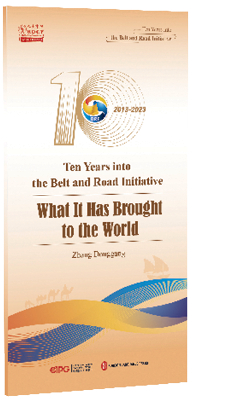
Ten Years into the Belt and Road Initiative
Editor-in-chief: Zhang Donggang
Price: RMB 48
Paperback
Published by Foreign Languages Press
The Belt and Road Initiative (BRI), since it was first proposed 10 years ago, has brought unprecedented changes to the world, and its groundbreaking, modern, and sustainable connectivity projects are reshaping the global landscape in many respects.
The book series Ten Years into the Belt and Road Initiative contains altogether eight booklets, which are respectively titled What It Has Brought to the World, Policy Coordination, People-to-people Exchanges, Unimpeded Trade, Facilities Connectivity, Financial Integration, Production Capacity Cooperation, and The Belt and Road Vision.
In the first booklet What It Has Brought to the World, the author puts forward the essential question, “What exactly is the BRI?” by outlining what the initiative seeks to achieve. Chinese President Xi Jinping shed light on the question at the Belt and Road Forum for International Cooperation in 2017. He pointed out that the BRI would strengthen the infrastructure and connectivity of countries, align their respective development strategies, and strive to achieve common development and prosperity through pragmatic cooperation.
Over the past 10 years, more than 150 countries and 30-odd international organizations around the world have signed on for more than 200 Belt and Road agreements with China. They pursue common development and prosperity by effectively coordinating bilateral or multilateral development strategies, advancing infrastructure construction, and promoting connectivity.
In the second booklet, Policy Coordination, the author quotes a German proverb, “A person’s effort is an additive effect; a team’s effort is a multiplication effect.” It is echoed by the Chinese proverb: “One thread is easy to break, but ten thousand threads bound together can pull a boat.” The BRI has become the largest international public goods and global cooperation platform following the path of multilateralism.
Policy coordination among participating countries has greatly promoted the building of the Green Silk Road and Digital Silk Road. In 2021, 29 countries including China, Kazakhstan, Singapore, and Indonesia jointly launched the BRI Green Development Partnership Initiative, calling for international cooperation to achieve a green and sustainable world economic recovery; and by the end of 2022, China had signed multiple memoranda of understanding on the Digital Silk Road cooperation with 17 countries and established bilateral cooperation mechanisms for “Silk Road E-commerce” with 23 countries.
The third booklet, People-to-People Exchanges, has the author expounding the good-neighborly diplomacy proposed by President Xi featuring “amity, sincerity, mutual benefit, and inclusiveness.” It is just one aspect of the five-pronged initiative, with the other four being policy coordination, facilities connectivity, unimpeded trade, and financial integration. China has always adhered to “good-neighborliness, amity, solidarity, and mutual assistance,” and advocated “more exchanges, more heart-winning and heartwarming deeds,” strengthening “people-to-people exchanges, making friends, and making good connections.”
Exploring the common characteristics of cultures and bridging the gap between them are the key to people-to-people bonding under the BRI. For instance, China shares a similar cultural background with countries in East Asia and Southeast Asia as their development history was intertwined to some extent, which has prompted more cultural exchanges among them. The rapid advancement of the Internet, smartphones, 5G communication, and other technologies has also greatly enhanced communication among the youngsters. Youth exchanges between BRI countries are more frequent, and more grounded in real life. Those exchanges can help bring peoples in the BRI countries closer to each other.
The fourth booklet, Unimpeded Trade, describes the concrete manifestation of mutual benefit and win-win results achieved in advancing the BRI, and the material foundation for building a community with a shared future for humankind. The BRI has created a new pattern of global trade. It facilitates the involved countries to align their development strategies, promotes trade and investment liberalization and facilitation, and strengthens international industrial capacity cooperation. Compound, multi-level, and all-round unimpeded trade networks are taking shape.
Facilities connectivity is thoroughly discussed in the fifth booklet, with ample evidence of bridges, highways, railways, ports, and cities jointly built by China and its BRI partners in countries along the routes mentioned in the book, which are helping fuel local economic development and creating a better life for people. Not only have many local “first roads” and “local landmark” infrastructure projects been built, but local factors of environment, society, and governance have also been improved accordingly.
The sixth booklet, Financial Integration, points out that the financing channels of the BRI partner countries have been effectively broadened, and finance’s “lifeblood” role given full play by efficiently accomplishing the basic mission of financing major engineering construction projects under the BRI, especially improving local infrastructure conditions. Moreover, provision of an effective supply of capital to developing countries facing shortfalls to ease their financing bottlenecks has been the top priority of the financial integration work.
In the seventh booklet, Production Capacity Cooperation, the author points out that through the BRI’s production capacity cooperation projects, numerous Chinese enterprises have successively gone global and expanded their international market, which has also boosted local development and improved local people’s livelihoods. In the future, with the participation of more enterprises and the involvement of more technological elements, the production capacity cooperation projects are expected to mushroom.
In the eighth and final booklet, The Belt and Road Vision, the author mentions that the BRI presents a new way to share the dividends of China’s development with the world. Looking ahead, the pursuit of the BRI will go in sync with China’s modernization drive. It will be the Belt and Road for peaceful development, for common prosperity, for mutual learning among civilizations, for digital innovation, and for green and low-carbon development.